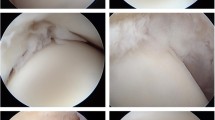Abstract
Purpose
Trimalleolar fractures are a common injury of the ankle that require surgical treatment to obtain an anatomic reduction of both malleoli and stabilization of the syndesmosis. This study aims to report the outcomes of surgical treatment for trimalleolar fractures, identifying the risk factors determining a worse result.
Materials and methods
Between January 2013 and December 2016, 48 patients with trimalleolar fracture treated with open reduction and internal fixation were retrospectively analyzed. The mean age was 44.69 years, and average body mass index (BMI) was 29.04. According to the Danis–Weber classification, 30 (62.5%) fractures were type B and 18 (37.5%) were type C. Clinical and radiographic evaluations at 3, 6, and 12 months were assessed. The functional results of Visual Analogue Staircases and Olerud–Molander (O&M) ankle score were reported.
Results
No significant difference was found among the size of the PM in patients with and without ankle dislocation (p = 0.364). Therefore, there is no correlation between the size of the posterior fragment and the ankle dislocation and the size of the posterior malleolus and syndesmosis stability (p = 0.328). Age over 61 years, BMI > 40, ASA > 1, type C fracture, and fracture dislocation were considered as negative prognostic fractures.
Conclusions
Surgical treatment for trimalleolar fractures needs accurate preoperative planning. Age over 61 years, BMI > 40, ASA > 1, type C fracture, and fracture dislocation were considered as negative prognostic fractures.
Similar content being viewed by others
References
Tenenbaum S, Shazar N, Bruck N, Bariteau J (2017) Posterior malleolus fractures. Orthop Clin N Am 48(1):81–89
Kukkonen J, Heikkilä JT, Kyyrönen T, Mattila K, Gullichsen E (2006) Posterior malleolar fracture is often associated with spiral tibial diaphyseal fracture: a retrospective study. J Trauma 60(5):1058–1060
Koval KJ, Lurie J, Zhou W et al (2005) Ankle fractures in the elderly: what you get depends on where you live and who you see. J Orthop Trauma 19(9):635–639
Duan X, Kadakia AR (2017) Operative treatment of posterior malleolar fractures. Open Orthop J 11:732–742
Bartoníček J, Rammelt S, Tuček M, Naňka O (2015) Posterior malleolar fractures of the ankle. Eur J Trauma Emerg Surg 41(6):587–600
Tejwani NC, Pahk B, Egol KA (2010) Effect of posterior malleolus fracture on outcome after unstable ankle fracture. J Trauma 69(3):666–669
Mandi DM (2012) Ankle fractures. Clin Podiatr Med Surg 29(2):155–186
Yablon IG, Leach RE (1989) Reconstruction of malunited fractures of the lateral malleolus. J Bone Joint Surg Am 71(4):521–527
Bali N, Aktselis I, Ramasamy A, Mitchell S, Fenton P (2017) An evolution in the management of fractures of the ankle: safety and efficacy of posteromedial approach for Haraguchi type 2 posterior malleolar fractures. Bone Joint J 99-B(11):1496–1501
Nelson MC, Jensen NK (1940) The treatment of trimalleolar fractures of the ankle. Surg Gynecol Obstet 71:509–514
Jindal N, Gupta P (2013) Comment on Xu et al.: a retrospective study of posterior malleolus fractures. Int Orthop 37(5):993–994
Fitz-Henry J (2011) The ASA classification and peri-operative risk. Ann R Coll Surg Engl 93(3):185–187
Danis R (1949) Les fractures malleolaires. In: Danis R (ed) Theorie et Pratique de l’Osteosynthese. Masson, Paris, pp 133–165
Fonseca LLD, Nunes IG, Nogueira RR, Martins GEV, Mesencio AC, Kobata SI (2017) Reproducibility of the Lauge-Hansen, Danis–Weber, and AO classifications for ankle fractures. Rev Bras Ortop 53(1):101–106
McBryde A, Chiasson B, Wilhelm A, Donovan F, Ray T, Bacilla P (1997) Syndesmotic screw placement: a biomechanical analysis. Foot Ankle Int 18(5):262–266
De Vries JS, Wijgman AJ, Sierevelt IN, Schaap GR (2005) Long-term results of ankle fractures with a posterior malleolar fragment. J Foot Ankle Surg 44(3):211–217
Jaskulka RA, Ittner G, Schedl R (1989) Fractures of the posterior tibial margin: their role in the prognosis of malleolar fractures. J Trauma 29(11):1565–1570
Hunt KJ, Goeb Y, Behn AW, Criswell B, Chou L (2015) Ankle joint contact loads and displacement with progressive syndesmotic injury. Foot Ankle Int 36(9):1095–1103
Vrahas M, Fu F, Veenis B (1994) Intraarticular contact stresses with simulated ankle malunions. J Orthop Trauma 8(2):159–166
Papachristou G, Efstathopoulos N, Levidiotis C, Chronopoulos E (2003) Early weight bearing after posterior malleolar fractures: an experimental and prospective clinical study. J Foot Ankle Surg 42(2):99–104
Solan MC, Sakellariou A (2017) Posterior malleolus fractures: worth fixing. Bone Joint J 99-B(11):1413–1419
Hartford JM, Gorczyca JT, McNamara JL, Mayor MB (1995) Tibiotalar contact area. Contribution of posterior malleolus and deltoid ligament. Clin Orthop Relat Res 320:182–187
Cho BK, Choi SM, Shin YD (2018) Prognostic factors for intermediate-term clinical outcomes following Bosworth fractures of the ankle joint. Foot Ankle Surg (Epub ahead of print)
Shao J, Zhang H, Yin B et al (2018) Risk factors for surgical site infection following operative treatment of ankle fractures: a systematic review and meta-analysis. Int J Surg 56:124–132
Heim UF (1989) Trimalleolar fractures: late results after fixation of the posterior fragment. Orthopedics 12(8):1053–1059
Shah NH, Sundaram RO, Velusamy A, Braithwaite IJ (2007) Five-year functional outcome analysis of ankle fracture fixation. Injury 38(11):1308–1312
Mingo-Robinet J, López-Durán L, Galeote JE, Martinez-Cervell C (2011) Ankle fractures with posterior malleolar fragment: management and results. J Foot Ankle Surg 50(2):141–145
Funding
This study was funded by the authors.
Author information
Authors and Affiliations
Corresponding author
Ethics declarations
Conflict of interest
All authors declare that they have no conflict of interest.
Ethical approval
All procedures performed in studies involving human participants were in accordance with the ethical standards of the institutional and/or national research committee and with the 1964 Helsinki declaration and its later amendments or comparable ethical standards.
Informed consent
Informed consent was obtained from all individual participants included in the study.
Additional information
Publisher's Note
Springer Nature remains neutral with regard to jurisdictional claims in published maps and institutional affiliations.
Rights and permissions
About this article
Cite this article
Testa, G., Ganci, M., Amico, M. et al. Negative prognostic factors in surgical treatment for trimalleolar fractures. Eur J Orthop Surg Traumatol 29, 1325–1330 (2019). https://doi.org/10.1007/s00590-019-02430-6
Received:
Accepted:
Published:
Issue Date:
DOI: https://doi.org/10.1007/s00590-019-02430-6




